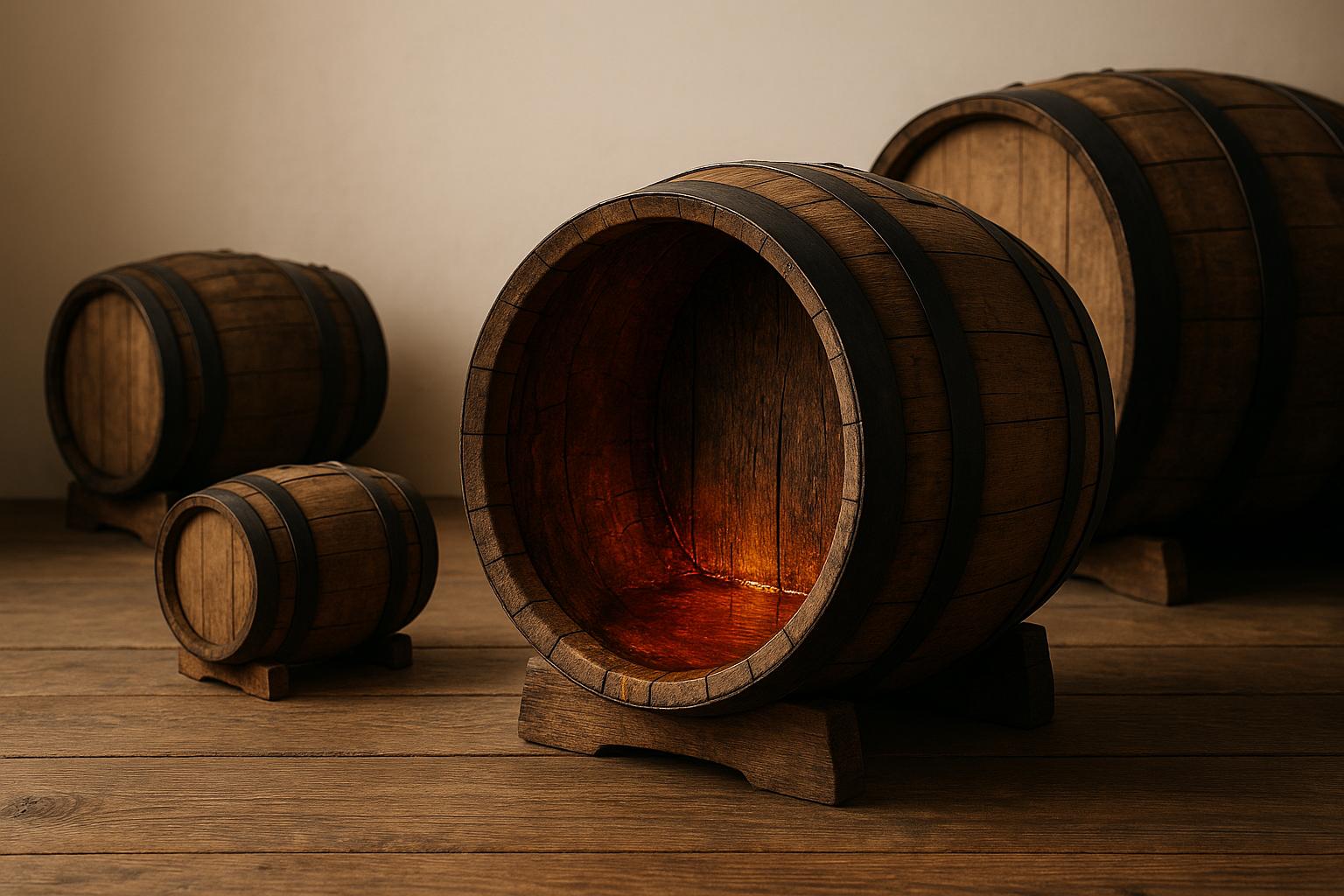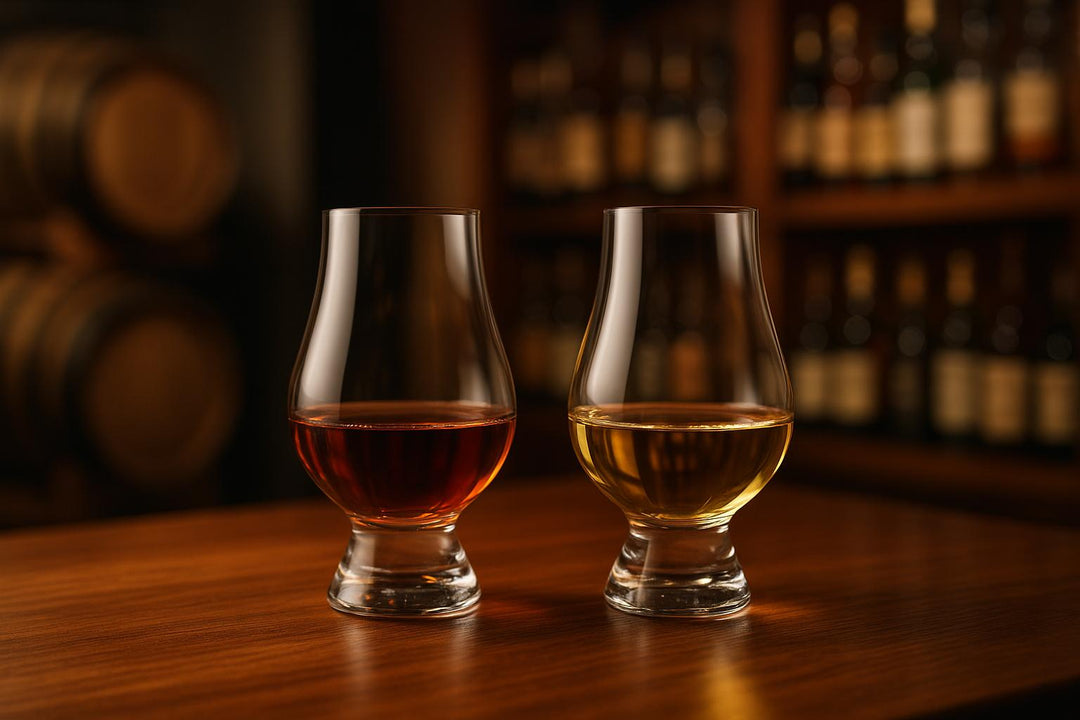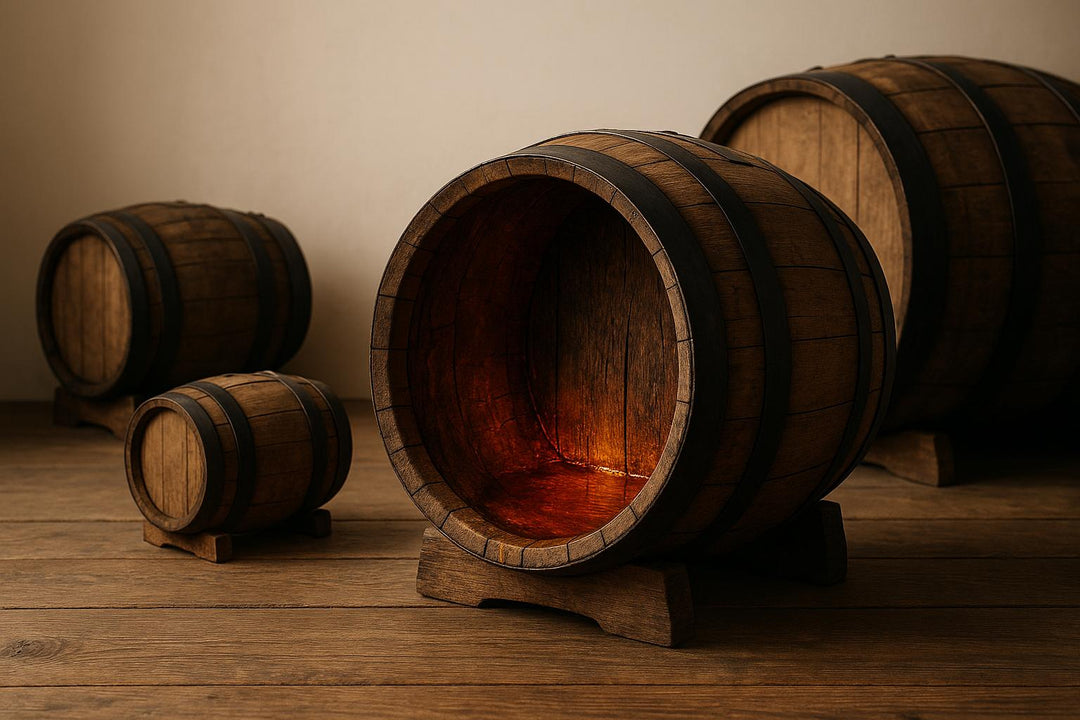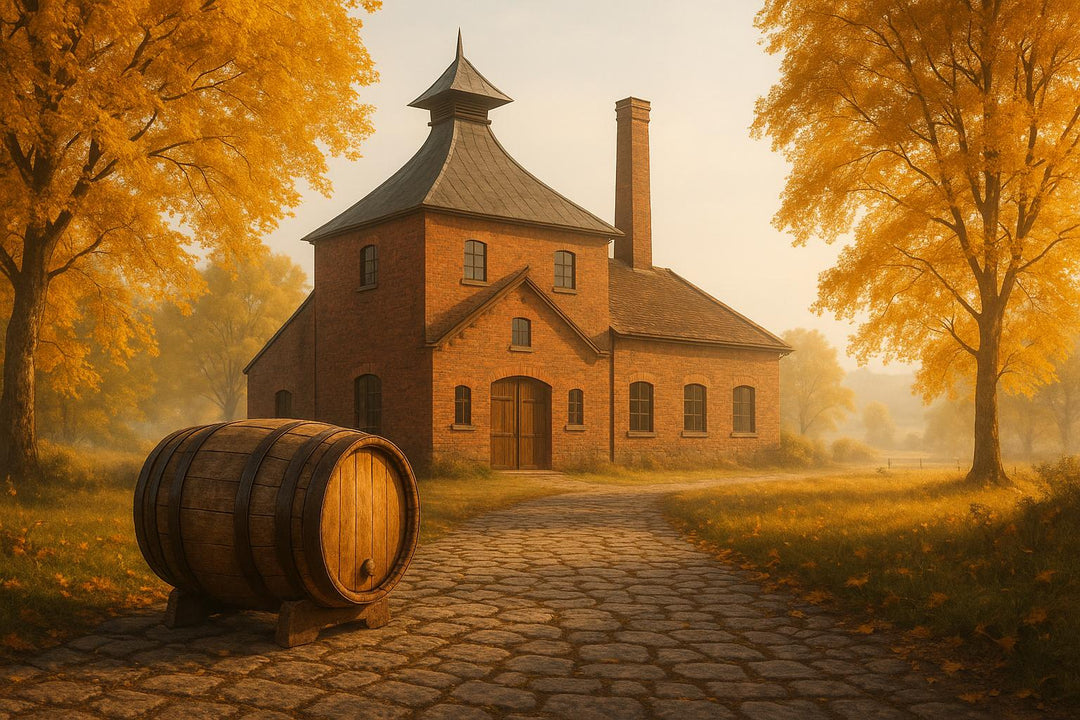The size of a whisky cask directly impacts its flavour and maturation process. Smaller casks, like quarter casks, create intense flavours faster due to a higher wood-to-spirit ratio. Larger casks, such as butts, allow for slower maturation, resulting in more subtle and complex profiles. Here's what you need to know:
- Smaller Casks (e.g., Quarter Casks): Faster maturation, bold oak flavours, but risk of over-oaking.
- Medium Casks (e.g., Hogsheads): Balanced maturation, preserving spirit character with moderate wood influence.
- Larger Casks (e.g., Butts): Slower maturation, nuanced flavours, ideal for long-term ageing.
Cask size also affects evaporation rates, with smaller casks losing more liquid ("angel's share") annually. Whisky makers carefully select cask sizes to match the desired flavour profile and ageing timeline.
Whisky Cask Sizes - Why Do They Matter? What Do They Mean?
Different Whisky Cask Sizes and Their Features
Each cask size brings its own unique influence to whisky maturation, shaping the flavours, aromas, and characteristics of the final product. Distilleries carefully choose casks to match the desired expression of their whiskies. Let’s take a closer look at some common cask types and their distinct features.
Quarter Cask (Small and Strong)
Quarter casks, with a capacity of 50–125 litres, were originally designed for ease of transport. Today, they’re prized for their ability to speed up maturation. Their smaller size increases the surface area of oak in contact with the whisky, resulting in bold, intense oak flavours in a shorter time [5]. However, this rapid extraction can sometimes lead to a less refined flavour profile [1], making them ideal for whiskies that benefit from shorter ageing or a pronounced oak influence.
American Standard Barrel (ASB)
The American Standard Barrel (ASB) holds 200 litres and plays a central role in modern whisky production. Originally crafted for bourbon, ASBs are now widely used for Scotch whisky maturation. They impart balanced notes of vanilla, caramel, and coconut [5][3][1], complementing the spirit without overpowering it.
Hogshead, Butt, and Puncheon Casks
Larger casks, such as hogsheads, butts, and puncheons, are designed for slower, more controlled ageing.
- Hogsheads (230–250 litres): These casks encourage gentle maturation, resulting in a spirit-forward profile [6].
- Butts (around 500 litres): Often associated with sherry maturation, butts allow for slow oxidation, which develops complex and nuanced flavours [3][8].
- Puncheons (500–700 litres): These larger casks, along with port pipes, are known for enhancing fruity aromas and adding a touch of sweetness to the whisky [5][3][8].
Alan Winchester, Master Distiller at The Glenlivet, highlights the importance of cask selection in whisky production:
"With 60-80% of the rich flavours of our whiskies coming from oak casks, coopers play an integral role in creating the heady aromas and lingering finishes of our most popular single malts." [7]
When working with these larger casks, distillers must carefully plan and allow for extended maturation times to achieve the desired depth and complexity. It’s a process that requires patience and expertise to bring out the best in every drop.
How Cask Size Changes Flavour and Maturation
Cask size plays a pivotal role in shaping whisky's flavour, influencing how the spirit interacts with wood and how it matures over time. A smaller cask, like a quarter cask, matures whisky differently compared to a larger sherry butt, and this difference comes down to factors like surface area, wood contact, and time.
Surface Area-to-Volume Ratio
One of the most important aspects of cask maturation is the surface area-to-volume ratio. This ratio determines how much of the whisky comes into contact with the oak, directly impacting the speed of flavour extraction. Smaller casks naturally provide more wood contact per litre of spirit, which accelerates the maturation process [4].
For instance, a 40-litre firkin offers approximately 48.8 litres of spirit per square metre of its inner surface area, while a 200-litre barrel has about 89.7 litres per square metre [2]. This means a firkin provides nearly double the oak interaction compared to a barrel. As cask size increases, the surface area per litre decreases significantly - if the cask capacity grows tenfold, the surface-to-volume ratio is halved; at a thousandfold increase, it drops to just 10% of the original ratio [4]. Distilleries carefully select cask sizes to align with their desired maturation timelines.
| Cask Type | Volume (litres) | Surface Area (sq metres) | Volume per sq metre (litres) |
|---|---|---|---|
| Firkin | 40 | 0.82 | 48.8 |
| Barrel | 200 | 2.23 | 89.7 |
| Hogshead | 250 | 2.59 | 96.5 |
| Sherry Butt | 500 | 4.03 | 124.1 |
How Size Affects Flavour Profiles
Smaller casks, such as octaves or quarter casks, allow whisky to extract flavours from the oak much faster. These casks infuse the spirit with intense woody notes, vibrant vanilla tones, and bold spices even at a younger age [9]. The increased wood contact results in a quicker uptake of tannins, vanillins, and other flavour compounds, creating whiskies with pronounced oak characteristics [4].
In contrast, larger casks like puncheons and sherry butts mature whisky more slowly due to their lower surface area-to-volume ratio [9][10]. This slower process allows for a gradual development of flavours, preserving much of the spirit's original character while introducing subtle complexities over time. For example, the sherry butt, with its 124.1 litres per square metre ratio, is ideal for long-term maturation, enabling decades of flavour development without overwhelming the spirit [2].
Risks of Over-Maturation
While smaller casks can speed up the maturation process, they come with certain risks. One of the main concerns is over-oaking, where the wood's influence becomes too dominant, overshadowing the whisky's natural character [1][11].
Smaller casks also tend to lose more alcohol through evaporation - often referred to as the "angel's share." Whisky in smaller casks can lose 0.5%–1% of alcohol annually, and this rate can be even higher due to the increased surface contact [3]. To manage these risks, distilleries use several strategies:
- Refill casks: These slow down maturation and reduce the risk of over-oaking.
- First-fill casks: These provide robust flavours quickly, while second-fill casks require more time to achieve balance [3][12].
- Finishing techniques: Transferring whisky to different casks for short periods can add layers of complexity without the risk of over-extraction [11].
Master distillers also play a crucial role, frequently tasting and evaluating the whisky to determine the perfect maturation time. This careful monitoring ensures the whisky strikes the right balance between the oak's influence and the spirit's own character [12]. By blending techniques and cask types, distilleries can achieve rich, complex whiskies while avoiding the pitfalls of excessive wood influence.
sbb-itb-128d6c1
Cask Size Comparison Table
To better understand how cask size influences whisky maturation, let’s break down some key metrics. The size of a cask plays a crucial role in determining the speed of flavour extraction and the level of wood influence, both of which significantly shape the final spirit.
Table of Cask Sizes
Here’s a side-by-side comparison of different cask types and their characteristics:
| Cask Type | Volume (Litres) | Surface Area (sq metres) | Volume per sq metre (litres) | Maturation Speed | Flavour Intensity | Common Usage |
|---|---|---|---|---|---|---|
| Quarter Cask | 120–125 | ~2.5 | ~50 | Very Fast | Very Intense | Craft distilleries, finishing |
| American Standard Barrel | 190–220 | 2.23 | 89.7 | Moderate | Balanced | Bourbon, Scotch whisky |
| Hogshead | 225–250 | 2.59 | 96.5 | Moderate | Subtle | Scotch whisky, blending |
| Wine Barrique | ~300 | ~3.2 | ~94 | Moderate | Varies | New World whisky |
| Butt | 475–500 | 4.03 | 124.1 | Slow | Nuanced | Sherry cask Scotch |
| Puncheon | 450–700 | ~5.5 | ~127 | Slow | Nuanced | Rum cask, port cask whisky |
The differences in surface area-to-volume ratios are particularly striking. For instance, a quarter cask allows for nearly 2.5 times more wood interaction per litre than a sherry butt[1]. This heightened interaction speeds up maturation and intensifies the flavour. On the other hand, larger casks like butts and puncheons slow the process, allowing the spirit to develop more gradually and retain its original character while absorbing subtle wood notes over time[13][14].
Hogsheads, which are about 20–25% larger than standard barrels, provide a middle ground. They slow the maturation process slightly compared to barrels, resulting in a more balanced flavour profile[13][14]. Meanwhile, butts and puncheons, being roughly double the size of hogsheads, extend the maturation period even further, which is ideal for creating nuanced and complex whiskies.
Another factor to consider is evaporation, often referred to as the "angel's share." Smaller casks can lose up to 2% of their liquid volume annually, compared to 0.5–1% in larger casks[3]. This faster evaporation not only concentrates flavours but also raises production costs, making smaller casks a more expensive choice for distillers.
These metrics highlight how cask size directly affects whisky maturation and flavour, offering a foundation for exploring other factors that shape the spirit.
Other Factors That Shape Whisky Flavour
The flavour of whisky is shaped by more than just the size of the cask. Elements like how the wood is treated, how often the cask has been used, and what it previously contained all play crucial roles. Let’s dive into how these factors come together to refine whisky's flavour.
Cask Treatment: Charring and Toasting
The way the inside of a cask is prepared before it’s filled significantly affects the whisky's flavour. Charring involves briefly burning the interior, creating a thin layer of charcoal - about 1/8 to 1/4 inch thick. This layer acts as a natural filter and adds distinct flavours to the spirit. The process is carried out at high temperatures, typically between 260°C and 315°C.
Toasting, on the other hand, is a gentler process. The wood is heated for around 15 minutes at 350°C, caramelising the wood's natural sugars without forming a charred layer. Vic Cameron from the Edinburgh Whisky Academy explains:
"Toasting is one of the heat treatments that we can do to the inside of a cask. It's when we heat the wood and we do some break down of the lignin in there to release compounds like sugars and aldehydes that can then go into the spirit." [16]
The level of treatment creates varied flavour profiles. Light toasting highlights delicate vanilla, floral, and fruity notes, while heavier toasting brings out richer flavours like chocolate, coffee, and dark fruits [16]. Charring levels are standardised across the whisky industry:
| Char Level | Flame Exposure | Flavour Profile |
|---|---|---|
| Level 1 | 15 seconds | Slightly sweet, with faint campfire notes |
| Level 2 | 30 seconds | Coffee, vanilla, and spice |
| Level 3 | 35 seconds | Caramelisation, vanilla, and spiciness |
| Level 4 | 55 seconds | Deep, sweet flavours |
Many distillers use a combination of charring and toasting. For instance, Wilderness Trail Distillery in Kentucky worked with Independent Stave Co. in 2018 to create barrels that underwent a 43-minute toast followed by a #4 char (a 60-second burn). Co-owner Shane Baker explained:
"A barrel will give up around two pounds of sugar over a five‑year maturation. We selected one of the different ranges of toast ISC offered that showed elevated caramels, chocolates, and vanillas. Toasting gives us more access to those sugars earlier in the aging process." [15]
Interestingly, smaller casks amplify these effects due to the increased surface area of wood in contact with the spirit.
First‑Fill vs. Refill Casks
A cask’s usage history is another major factor in shaping whisky. First‑fill casks - those being used for the first time - impart about 80% of the wood’s flavour, while refill casks offer a more subdued influence, contributing around 60%. For perspective, a second‑fill bourbon barrel delivers about 25–30% of the flavour impact of a first‑fill, and a third‑fill drops to roughly 10%. Sherry casks retain more potency, with second‑fill casks offering about 50% of the first‑fill impact and third‑fill casks contributing 15–20% [18].
Dr Bill Lumsden from Glenmorangie highlights the importance of refill casks for certain whisky expressions:
"For Glenmorangie Original second fill casks are critically important, as these casks give more fruit flavour, particularly a citrus bite, compared to a first fill. These fruit flavours come through partly from the character of the new make spirit, and also from the effects of oxidation, as second fill casks allow the spirit character and effects of oxidation to show through more than they would in a first fill cask." [18]
Timing also plays a role. First‑fill bourbon casks are ideal for ageing whisky up to 15–18 years, but beyond this, they can risk over‑woodiness. Refill bourbon casks, by contrast, are better suited for longer maturations of 18–40+ years, allowing subtler oak flavours to develop while preserving the distillery’s unique character [17]. Together, the history of cask use, its size, and the treatment it undergoes all contribute to the whisky's final flavour.
Previous Contents and Wood Type
The cask’s past life and the type of wood used add even more complexity to whisky's flavour. In a standard 500-litre barrel, about 7 litres of the previous liquid remains absorbed in the wood. It’s estimated that 50–80% of a whisky’s flavour comes from the cask ageing process [20].
Different cask contents leave distinct flavour signatures:
- Bourbon casks: Vanilla, coconut, caramel, and wood notes
- Sherry casks: Dried fruits, dark chocolate, and spices
- Ex‑Port casks: Ruby port adds red fruit, forest berries, and dark chocolate; Tawny port imparts dried fruits, aged oak, and nutty flavours [19]
The type of oak used also matters. American oak tends to produce sweet flavours like vanilla and caramel, while European oak contributes savoury notes such as leather and spice [22]. Tyler Bullock from The Oak Raleigh summarises it well:
"Oak casks wield significant influence, contributing 60–70% of the final flavor profile." [21]
The combination of previous contents and wood type can create fascinating contrasts. For example, a first‑fill sherry butt imparts rich, nutty flavours over time, while a smaller first‑fill sherry quarter cask delivers a bold, intense sherry character much faster. Larger casks allow for a slower, more nuanced flavour development, while smaller casks create a more immediate impact.
These factors - wood treatment, cask history, previous contents, and wood type - work together to create the intricate flavour profiles that make each whisky unique. Cask size might determine the pace of maturation, but it’s the interplay of these elements that defines the whisky’s character.
Choosing Whiskies Based on Cask Size
Now that you understand how cask size influences flavour development, you can use this knowledge to guide your whisky choices. The size of the cask plays a key role in shaping the taste, allowing you to select whiskies that match your personal preferences.
How Cask Size Affects Flavour
Cask size has a direct impact on the whisky's character. Smaller casks, with their higher wood-to-spirit ratio, extract flavours from the wood more quickly. This means whiskies aged in smaller casks, like quarter casks or American Standard Barrels (ASBs), tend to have bold and intense wood-driven notes.
On the other hand, larger casks, such as hogsheads or butts, provide a more gradual maturation. This slower process allows for extended oxidation, leading to complex and nuanced flavours. If you enjoy a balanced and refined whisky with subtle layers, these larger casks are your best bet.
While cask size plays a significant role, remember that the type of wood and the cask's previous contents also influence the whisky's profile. Whether you're choosing a whisky for a special occasion or a reliable everyday dram, these factors come together to create a unique experience with each sip.
Explore Cask-Matured Whiskies with The Really Good Whisky Company

With your newfound understanding of cask size, you can dive into the diverse range of whiskies available at The Really Good Whisky Company. Their collection spans everything from bold quarter cask releases to elegant, long-matured whiskies aged in large butts and puncheons.
Looking for rich, fruity depth? Try a first-fill sherry butt. Prefer something that highlights the distillery's natural character? Opt for a refill hogshead. They even offer bespoke bottling services, allowing you to tailor cask types and sizes for corporate gifts or personal milestones.
If you're curious to compare how cask size affects flavour, their tasting packs are a fantastic starting point. These packs let you explore variations from the same distillery, showcasing the influence of different cask sizes. And for those seeking something truly special, their rare and old whisky collection highlights the incredible complexity that comes with extended maturation in the right cask.
With expert advice, worldwide shipping, and a carefully curated selection, The Really Good Whisky Company makes it easy to find whiskies that suit your taste and deepen your appreciation for the art of cask maturation.
FAQs
How does cask size impact the risk of a whisky becoming over-oaked during maturation?
Smaller casks tend to speed up the interaction between whisky and wood because of their larger surface area relative to their volume. This quicker process can lead to a more intense extraction of flavours like tannins and oak. While this can add layers of flavour, it also comes with the risk of the whisky becoming overpowered by oak notes if it spends too much time in the cask.
Larger casks, however, slow things down, allowing for a more gradual and measured maturation process. This makes the choice of cask size a critical factor in shaping the whisky’s final flavour profile.
How does the size of a cask affect the speed and intensity of whisky maturation?
The size of a cask is a key factor in whisky maturation, largely because it affects the surface area-to-volume ratio. Smaller casks have a higher ratio, meaning more whisky is exposed to the wood. This accelerates flavour extraction, enhancing notes like oak, spice, and sweetness in a shorter time.
In contrast, larger casks slow this process down, allowing flavours to develop more gradually and subtly. Striking the right balance between cask size and maturation time is just one of the elements that elevates whisky production to an art.
How do the previous contents and wood treatment of a cask affect the flavour of whisky?
The type of wood and its previous contents have a huge impact on the flavour of whisky. As whisky matures in a cask, it absorbs compounds from the wood - like vanilla, caramel, spices, and tannins - which deepen and enrich its taste.
If the cask once held sherry, wine, or other spirits, it can lend the whisky additional flavours, such as dried fruits, nuttiness, or a touch of sweetness. How the wood is treated also matters. Techniques like charring or toasting can bring out smoky or caramelised notes, adding layers of complexity. All these elements work together to shape the whisky's unique character, making the cask an integral part of the ageing process.







Leave a comment